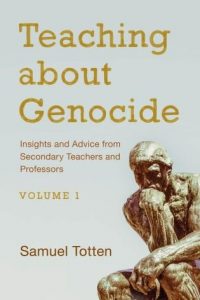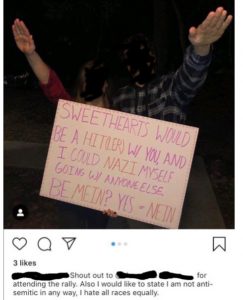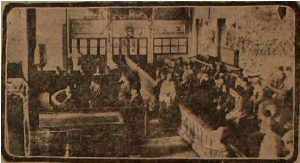Situated adjacent the National Mall in Washington D.C., the United States Holocaust Memorial Museum (USHMM) dominates the landscape of American Holocaust consciousness, remembrance, and education. On an elevator ride to the sixth floor and the start of the permanent exhibit, visitors to the museum watch a 15-second-long video showing footage of American soldiers encountering one of the concentration camps in 1945. In a retrospective voiceover, one soldier reflects on his initial shock at seeing the horrors of the camp: “We had come across something and were not sure what it was – a big prison of some kind. There were people running all over: sick, dying, starved people. You can’t imagine it; things like that don’t happen.” This video foreshadows the incomprehensibility of the Holocaust that visitors are about to witness in the permanent exhibit. The video also serves to perpetuate an American Holocaust myth; the myth that Americans had little to no knowledge of the Holocaust until the reporting of the liberation of the camps in 1945. For, as the myth goes, had Americans known about the atrocities, surely, they would have done something to speak out, to collectively, publicly condemn the mass murder of European Jewry. Though it is entirely possible that this individual soldier may not have known about the Nazi camps, the opening of Dachau in 1933, the persecution and plight of Germany and Europe’s Jews, and the ultimate extermination of millions were widely reported in the New York Times and local papers across the country. A recently-opened exhibit at the USHMM, Americans and the Holocaust, seeks to examine what ordinary Americans knew about the Holocaust in the 1930s and 40s.
In March 2019, the Dutch newspaper NRC Handelsblad ran a four-part series examining antisemitism in the Netherlands and Europe. Published in the midst of global concerns regarding the rise of antisemitism and violent antisemitic attacks, the question of the resurgence of anti-Jewish sentiment is more pressing than ever. According to the Center for Information and Documentation Israel (CIDI), there was a 19% increase in cases of antisemitism in the Netherlands from 2017 to 2018. In a survey conducted by the NRC, 70% of Jewish respondents (163 out of 800 identified themselves as Jewish) stated that antisemitism is indeed on the rise and 80% stated that while they have not witnessed antisemitism themselves, they are worried about its growth. This survey is backed by a recent investigation of antisemitism in twelve EU-member states. 89% of European Jews stated they experienced an increase in antisemitism in their home country, with another 38% responding that they have considered emigrating because they feel unsafe.
Twenty-five years have now passed since the Rwandan genocide. On the evening of April 6th, 1994, the assassination of President Juvénal Habyarimana served as a final trigger for violence after decades of propaganda, animosity, and killing. Within 100 days, 800,000 Tutsis were dead, as were numerous Hutu political opponents of the genocidal state.

Many Rwandans and foreigners have sought to capture this moment through media coverage, memoirs, film, and documentaries. Images of the killings and of refugee processions, of machetes and of bullet holes, are familiar across the world. But for those who grew up in the aftermath of the 1994 genocide, the pain of this violence is far more immediate than these decades-old snapshots have the capacity to show.
The 2019 Minneapolis-St. Paul International Film Festival kicks off Thursday with more than two weeks of films from around the world spread across theaters in the Twin Cities and Rochester. Included in this year’s festival are a number of movies that have piqued the interested of several of us at the Center for Holocaust & Genocide Studies.
Read on to get our picks for some of this year’s can’t miss films:

We’re at crossroads today: learning lessons from the Holocaust is fundamentally important. Understanding the dire consequences of hate and intolerance is more important today than just about any point in history. Unfortunately, it comes at a time when our memory of the Holocaust is fast fading. It seems as we continue to lose survivors and their critical connection to the past, we lose our willingness to apply their lessons to our own time. A year ago, the Conference on Jewish Material Claims Against Germany brought this sobering reality to the forefront: Nearly half of millennials cannot name a single concentration camp. Nearly a third of Americans drastically underestimate the number of victims of the Holocaust. Most astounding, almost 70% of Americans say they don’t care about the Holocaust.
In the woods of northern Minnesota, tucked along the shores of Turtle River Lake, is a small German village called
 Teaching about Genocide (Volume I), the first of a two-volume series edited by well-known Holocaust and genocide education scholar Samuel Totten, provides cogent, practical advice for those wishing to bring this difficult topic into their classrooms. The book builds on Totten’s previous work but is unique in its specific focus on combining insights from both secondary and post-secondary educators in each volume. Roughly half of the chapters were written by secondary educators, with the remaining composed by post-secondary professors and instructors. This combination helps to bridge the persistent gap between academic genocide studies research and secondary classroom teaching about genocide. Indeed, as a high school teacher of a semester-long comparative genocide studies course, I have often struggled to find ways to approach various aspects of genocide with my students. This volume both reaffirms the importance of genocide education while providing practical support for classroom teachers.
Teaching about Genocide (Volume I), the first of a two-volume series edited by well-known Holocaust and genocide education scholar Samuel Totten, provides cogent, practical advice for those wishing to bring this difficult topic into their classrooms. The book builds on Totten’s previous work but is unique in its specific focus on combining insights from both secondary and post-secondary educators in each volume. Roughly half of the chapters were written by secondary educators, with the remaining composed by post-secondary professors and instructors. This combination helps to bridge the persistent gap between academic genocide studies research and secondary classroom teaching about genocide. Indeed, as a high school teacher of a semester-long comparative genocide studies course, I have often struggled to find ways to approach various aspects of genocide with my students. This volume both reaffirms the importance of genocide education while providing practical support for classroom teachers.
The necessity for such a work at this moment is clear. While the Holocaust, especially since the mid-1990s, has become a mainstay of American K-12 school curriculum, teaching about so-called “other” genocides or “genocides other than the Holocaust,” has become increasingly common across the country. Though, despite this trend, few resources exist for educators, who, are often left to teach such difficult topics with little content or pedagogical support.
 Last week, two students from Minnetonka High School in suburban Minneapolis posted a photo of themselves giving a Nazi hand salute accompanied by an antisemitic sign. This incident is just the latest of a number of similar instances, with photos surfacing from Indiana and Wisconsin showing students giving the Nazi salute. Understandably, each case has sparked calls for more and better Holocaust education in schools. This latest photo prompts the question: what do students in Minnesota’s public schools learn about the Holocaust?
Last week, two students from Minnetonka High School in suburban Minneapolis posted a photo of themselves giving a Nazi hand salute accompanied by an antisemitic sign. This incident is just the latest of a number of similar instances, with photos surfacing from Indiana and Wisconsin showing students giving the Nazi salute. Understandably, each case has sparked calls for more and better Holocaust education in schools. This latest photo prompts the question: what do students in Minnesota’s public schools learn about the Holocaust?
Gauging the state of Holocaust education in the United States is no easy task. The decentralized nature of American public schooling means that state departments of education, local districts, and individual classroom teachers decide what to teach and how it is taught. No comprehensive survey of the state of American Holocaust education exists, and such an assessment would be nearly impossible to conduct. The New York Times recently reported on an unsettling survey, which found that while the majority of Americans believe Holocaust education is important, many people, especially millennials, lack even a basic awareness of the history of the Holocaust. In 2013, Rhonda Fink-Whitman’s viral YouTube video showing American college student’s lack of knowledge of the Holocaust renewed a push for Holocaust education legislation in Pennsylvania and across the country. Indeed, Pennsylvania joined a growing list of states that have passed Holocaust education legislative mandates.
 One hundred years ago this month, facing defeat and pressure from the Allied powers than won WW I, the Ottomans began attributing blame for the massacre of its Armenian and Greek citizens. Putting the Three Pashas (Talat, Enver & Djemal) on trial with other leaders of the Committee of Union and Progress, the Turkish Military Tribunals found the defendants guilty and sentenced to death. However, , the Pashas were able to flee Turkey and escape punishment (for some time, at least). The allies, frustrated by the perceived ineffectualness of the Turkish courts, in turn established the Malta Court to prosecute war criminals. By 1922, though, the Turkish defendants were repatriated to Turkey, largely due to the absence of a legal framework for prosecution. The lack of justice from the international community would spur a young Raphael Lemkin toward a lifelong goal of pursuing legal safeguards to prevent massacres like those of the Armenians from reoccurring.
One hundred years ago this month, facing defeat and pressure from the Allied powers than won WW I, the Ottomans began attributing blame for the massacre of its Armenian and Greek citizens. Putting the Three Pashas (Talat, Enver & Djemal) on trial with other leaders of the Committee of Union and Progress, the Turkish Military Tribunals found the defendants guilty and sentenced to death. However, , the Pashas were able to flee Turkey and escape punishment (for some time, at least). The allies, frustrated by the perceived ineffectualness of the Turkish courts, in turn established the Malta Court to prosecute war criminals. By 1922, though, the Turkish defendants were repatriated to Turkey, largely due to the absence of a legal framework for prosecution. The lack of justice from the international community would spur a young Raphael Lemkin toward a lifelong goal of pursuing legal safeguards to prevent massacres like those of the Armenians from reoccurring.
In October, the Center for Holocaust & Genocide Studies welcomed Hasan Hasanovic to campus to discuss his experience as a survivor of the Srebrenica genocide. Mr. Hasanovic was 18 when Bosnian Serbs systematically murdered more than 8,000 Bosniak men and boys in July 1995. Since then, Mr. Hasanovic has written an account of his story, Surviving Srebrenica (The Lumphanen Press, 2016), and spoken around the world on the topic of Srebrenica and genocide more broadly. For the last decade, he has served as a curator at the Srebrenica Memorial.
Joe Eggers: I’ve watched several of your interviews on television and especially your presentations at schools. What’s one message you hope they take away after you speak?
Hasan Hasanovic: It’s interesting. After the Holocaust, the whole world said “never again.” And very similar things were [still] happening afterwards—in Rwanda, Darfur, Cambodia, Bosnia. It’s happening here and now with Rohingya Muslims. Now we have this situation in China with Muslims—one million are being held in labor camps. Somehow we don’t have a mechanism to prevent these atrocities. We talk about them after ten, twenty years, and we feel sorry for victims and we try to say something about it and try to educate people, and that’s it. But what is lacking is that global mechanism, which should be the United Nations. Sadly, world powers have different interests and those interests are standing the way of global intervention and prevention of mass atrocities. I’m trying in a way to make a point that we need to talk about it and to make sure we keep that memory alive and to educate people, but at the same time remember that it’s still happening. And my hope is that when I talk to these audiences—that some of them will become politicians, some of them will pursue other professions—they will use this story and other stories of other atrocities in their lives, as a lesson, and they will become better individuals, better politicians, more humane politicians. And if they get a chance…to decide something that they will make an appropriate decision, thinking from a humane perspective, rather than the perspective of the interests of their political party or the interests of that power.
